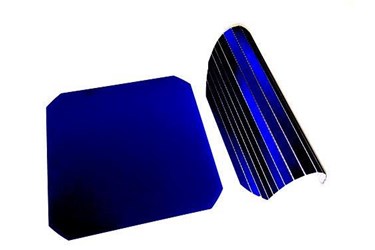Flexible, high-performance solar cells could become portable power sources
Thin and rigid silicon segments that are wired through interdigitated metal contacts are said to produce flexible, high-performance solar cells.

A strategy, developed by KLAST, that uses a screen-printed aluminium circuit to make silicon solar cells flexible could enable them to become portable power sources.
Demand for wearable and implantable devices, foldable displays and vehicle-integrated solar panels are among some of the technology that could benefit, KLAST says.
Crystalline silicon is an appealing material for the development of industrial solar cells because of its reliable and consistent photovoltaic properties. However, its rigidity and weight have raised challenges when it comes for application in flexible electronics.
KLAST says that previous attempts made to enhance the material’s flexibility with thin films, whilst maintaining device performance, have fallen short.
Solar cells are said to have shown a drop in performance for films thinner than 250 micrometers. "At this thickness, one cannot achieve flexible silicon solar cells," says team leader, Muhammad Hussain.
Hussain's team claims to have created a corrugated array comprising thin, rigid silicon segments using so-called interdigitated back contact solar cells. The segments are interconnected by screen-printed aluminum contacts. These contacts are positioned at the rear to optimise light absorption at the front of the solar cell and facilitate any modifications of the active silicon material. The array can apparently bend and adopt various configurations without cracking or losing its power conversion efficiency.
Starting from large-area crystalline silicon solar cells, the team etched a small portion of the cells into 140-micrometer-thick strips, while keeping the thickness of the remaining portion above 240 micrometers. "This allowed us to lower the bending radius of the cell to 140 micrometers, while retaining the efficiency of the bulk (18%), record achievements for both silicon solar cell efficiency and bendability," explains lead author, Rabab Bahabry.
According to the team, they were able to show that a series of five corrugated solar cells lit up multicolored light-emitting diodes. They also wrapped the cells around a glass mug, which they claim powered a miniature humidity detection system placed on a plant leaf. When exposed to light from a desk lamp and humid conditions, the system apparently turned on an LED and sent a notification to a smartphone.
The team aim to explore the ways they can exploit these corrugated solar cells, which Hussain believes can be deployed in the most complex topologies. "Our approach is suitable for the Internet of Things and can meet a wide application spectrum," he concludes.
在线留言询价
- 一周热料
- 紧缺物料秒杀
| 型号 | 品牌 | 询价 |
|---|---|---|
| MC33074DR2G | onsemi | |
| CDZVT2R20B | ROHM Semiconductor | |
| RB751G-40T2R | ROHM Semiconductor | |
| BD71847AMWV-E2 | ROHM Semiconductor | |
| TL431ACLPR | Texas Instruments |
| 型号 | 品牌 | 抢购 |
|---|---|---|
| IPZ40N04S5L4R8ATMA1 | Infineon Technologies | |
| STM32F429IGT6 | STMicroelectronics | |
| TPS63050YFFR | Texas Instruments | |
| BP3621 | ROHM Semiconductor | |
| ESR03EZPJ151 | ROHM Semiconductor | |
| BU33JA2MNVX-CTL | ROHM Semiconductor |
- 周排行榜
- 月排行榜
AMEYA360公众号二维码
识别二维码,即可关注


请输入下方图片中的验证码:






















